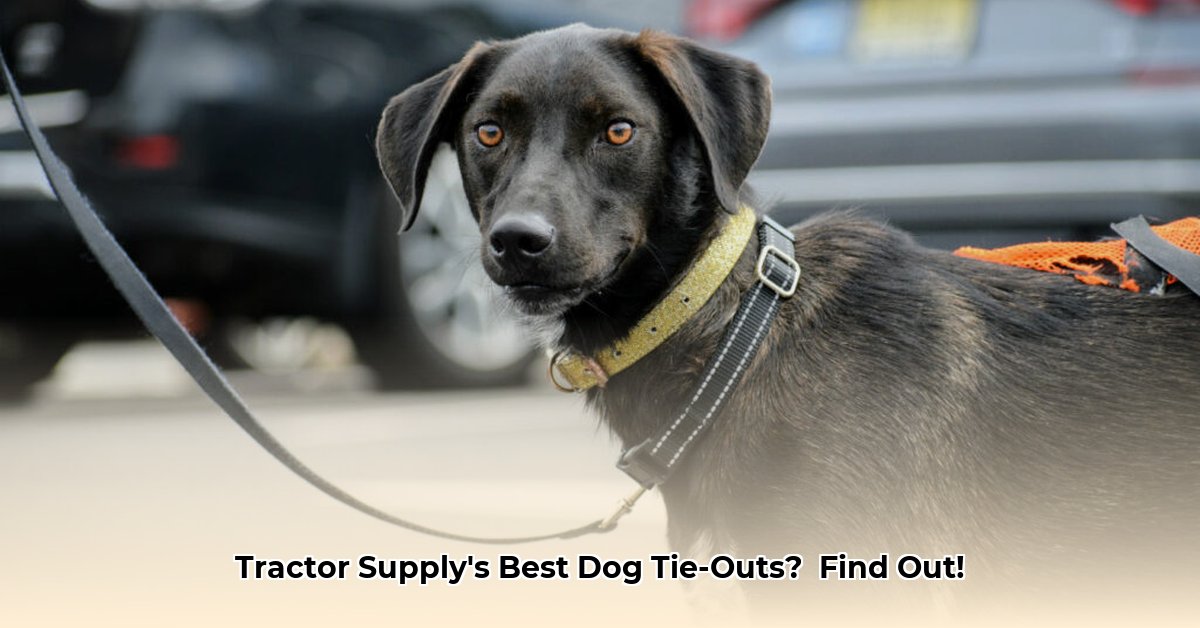
Choosing the right tie-out for your canine companion is crucial for their safety and well-being. With numerous options available at Tractor Supply, selecting the ideal system can be overwhelming. This comprehensive guide simplifies the process, providing actionable steps and insights to ensure your dog's outdoor experiences are both enjoyable and secure. We'll cover essential considerations, product types, and safety best practices, empowering you to make an informed decision for your furry friend. For more options, check out Tractor Supply Dog Runs.
Understanding Your Dog's Needs: A Crucial First Step
Before you even browse Tractor Supply's offerings, consider your dog's individual characteristics. Breed, size, weight, and temperament significantly influence the type of tie-out required. A small, docile dog will have different needs than a large, powerful breed. How strong is your dog's pulling power? A dog that pulls strongly needs a heavy-duty tie-out system to prevent accidents. What is your dog's personality? A more energetic dog might require a swivel tie-out to prevent tangling. Does your dog have a tendency to chew? A chew-resistant, heavy-duty system is a must for these destructive pups. Finally, assess your yard's layout and size to determine the appropriate tie-out length, ensuring sufficient space for movement while preventing access to hazards.
Tractor Supply's Tie-Out Options: A Detailed Overview
Tractor Supply offers a range of tie-outs, each catering to specific needs. Let's explore the common types:
Heavy-Duty Tie-Outs: Maximum Strength and Durability
These tie-outs are designed for robust performance, ideal for large and powerful breeds. Think of heavy-gauge steel cables or exceptionally strong ropes anchored to sturdy stakes. These options withstand vigorous pulling and are less likely to break under strain. However, they can be less flexible compared to other types.
Swivel Tie-Outs: Enhanced Mobility and Safety
Swivel tie-outs allow your dog to freely rotate without becoming entangled. This prevents twisting, potential strangulation, and frustration. The swivel mechanism is a critical safety feature, especially for dogs that tend to pull. Though generally more expensive than static tie-outs, the enhanced safety makes them a worthwhile investment for active dogs.
Retractable Tie-Outs: Adjustable Range and Freedom
Retractable tie-outs offer adjustable lengths, providing greater flexibility in your dog’s roaming area. The cord or cable retracts smoothly, giving your dog more room to move. However, always check the weight limit carefully, as exceeding it can lead to breakage. Inspect for wear and tear regularly.
Chain Tie-Outs: Unwavering Strength and Chew Resistance
Chains are exceptionally strong and highly resistant to chewing. This makes them a durable solution for dogs with a penchant for destruction. However, chains can be noisy and may be harsh on paws. They are generally less flexible than other options.
Selecting the Perfect Tie-Out: A Practical Step-by-Step Guide
Choosing the right tie-out involves careful consideration of several factors. Follow these steps to ensure a safe and suitable choice:
Precise Measurements: Accurately measure your dog's weight and size. Cross-reference this information with the tie-out's weight capacity. Always opt for a system with a weight capacity exceeding your dog's weight.
Environmental Assessment: Analyze your yard or outdoor space. Note any obstacles, potential hazards, or uneven terrain that could impact tie-out placement and length. Ensure sufficient space for safe movement, avoiding potential dangers.
Uncompromising Safety: Verify the secure attachment of the tie-out to the stake or anchor point. A strong, reliable connection is paramount to prevent accidents. Regular inspections are crucial to identify and address any signs of wear or damage.
Material Evaluation: Choose durable, weather-resistant materials. Galvanized steel, heavy-duty rope, or sturdy chain are preferred choices for long-term reliability and safety.
Leverage Customer Reviews: Before purchasing, thoroughly review online customer feedback. Real-world experiences often highlight both the strengths and weaknesses of different tie-out systems. This can provide valuable insights and help you avoid potential issues.
Responsible Tie-Out Usage: Prioritizing Safety and Well-being
Remember that a tie-out is a tool to provide supervised outdoor time, not a replacement for proper exercise, training, and attention. Never leave your dog unattended for extended periods. Always provide access to fresh water and shade, particularly during hot weather. Regularly inspect the tie-out for any signs of wear, tear, or damage, replacing it immediately if necessary. "A well-maintained tie-out is essential for your dog’s safety," advises Dr. Emily Carter, Veterinarian at Animal Wellness Clinic. Prioritize responsible use to ensure your dog’s safety and happiness.